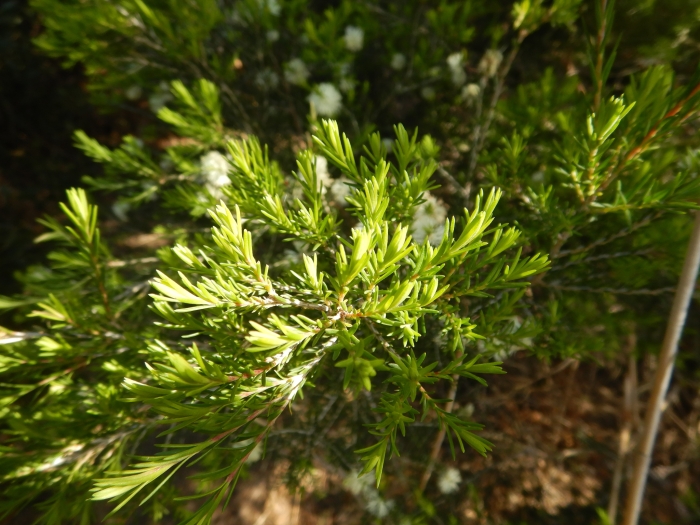Swamp Paperbark
(Melaleuca ericifolia)
Swamp Paperbark (Melaleuca ericifolia)
/
/

Paul J. Morris
CC BY-SA 4.0
Image By:
Paul J. Morris
Recorded By:
Copyright:
CC BY-SA 4.0
Copyright Notice:
Photo by: Paul J. Morris | License Type: CC BY-SA 4.0 | License URL: http://creativecommons.org/licenses/by-sa/4.0/ | Rights Holder: Paul J. Morris | Publisher: iNaturalist | Date Created: 2023-10-18T17:04:38-07:00 |



















Estimated Native Range
Summary
Melaleuca ericifolia, commonly known as Swamp Paperbark, is an evergreen tree or large shrub native to coastal swamps and wetlands in southeastern Australia, including Tasmania. It typically grows to heights of up to 30 feet (9 meters) and has a multi-stemmed habit with a broad, irregular crown. The bark is characteristically thick, fibrous, and spongy, peeling off in large sheets reminiscent of paper. The foliage consists of narrow, lance-shaped leaves, and the plant produces small, prolific creamy-white flower heads that are highly attractive to bees and other pollinators. Flowering occurs mainly in summer, but sporadic blooms can be found throughout the year.
Swamp Paperbark is valued for its ability to thrive in wet conditions and is often used in the rehabilitation of swampy areas due to its clonal nature and fast growth. It is also appreciated for its ornamental bark and flowers, which add textural interest to water gardens and riparian plantings. In cultivation, it requires consistently moist soil and full sun to part shade. It is tolerant of waterlogged soils and can be used to stabilize stream banks. However, care should be taken as Melaleuca ericifolia can become invasive outside its native range, particularly in wetland habitats. It is also susceptible to webbing caterpillars and myrtle rust, which can affect its health and appearance.CC BY-SA 4.0
Swamp Paperbark is valued for its ability to thrive in wet conditions and is often used in the rehabilitation of swampy areas due to its clonal nature and fast growth. It is also appreciated for its ornamental bark and flowers, which add textural interest to water gardens and riparian plantings. In cultivation, it requires consistently moist soil and full sun to part shade. It is tolerant of waterlogged soils and can be used to stabilize stream banks. However, care should be taken as Melaleuca ericifolia can become invasive outside its native range, particularly in wetland habitats. It is also susceptible to webbing caterpillars and myrtle rust, which can affect its health and appearance.CC BY-SA 4.0
Plant Description
- Plant Type: Shrub, Tree
- Height: 15-30 feet
- Width: 10-25 feet
- Growth Rate: Moderate
- Flower Color: White
- Flowering Season: Spring
- Leaf Retention: Evergreen
Growth Requirements
- Sun: Full Sun, Part Shade
- Water: Medium
- Drainage: Fast, Medium, Slow
Common Uses
Bird Garden, Erosion Control, Hedges, Low Maintenance, Showy Flowers, Street Planting, Water Garden
Natural Habitat
Native to coastal swamps and wetlands in southeastern Australia, including Tasmania
Other Names
Common Names: Swamp Paperbark, Rosy Paperbark, Swamp Teatree, Ericifolia, Marsh Tea-tree
Scientific Names: , Melaleuca ericifolia, Cajuputi ericifolia, Kajuputi ericifolia, Melaleuca axillaris, Melaleuca gunniana, Melaleuca gunniana var. capitata, Melaleuca heliophila, Melaleuca heliophila, Melaleuca pinifolia
GBIF Accepted Name: